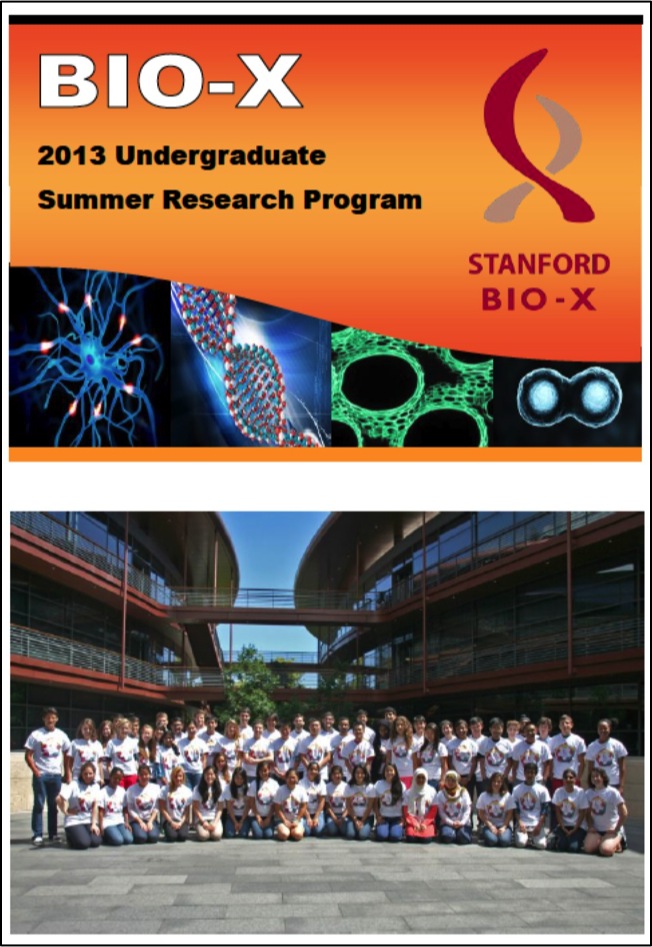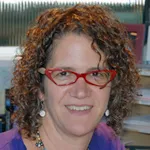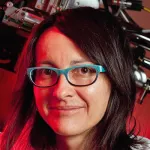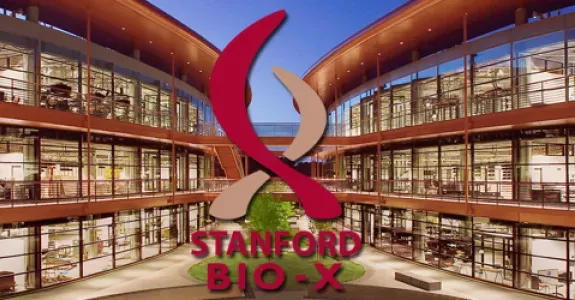
Welcome to the biweekly electronic newsletter from Stanford Bio-X for members of the Bio-X Corporate Forum. Please contact Dr. Hanwei Li, the Bio-X Corporate Forum Liaison if you would like to be added or removed from this distribution list, or if you have any questions about Stanford Bio-X or Stanford University.
Highlights
** On October 9, 2013, Bio-X celebrated the 10th Anniversary of the James H. Clark Center, the hub of Bio-X. Check out CLARK CENTER @ 10X as well as the Bio-X Timeline over the last 15 years!!
** Check out the article by Stanford President John Hennessy in the Nov/Dec 2013 issue of the Stanford Magazine on Bio-X and the Clark Center, "A Cauldron of Innovation".
Seed Grants
**UPDATE: BIO-X HAS 22 NEWLY AWARDED IIP SEED GRANT PROJECTS FOR ROUND 7 in 2014!! Click on the link to check out the project descriptions and read on to learn more about this round!
 SEED GRANTS FOR SUCCESS - Stanford Bio-X Interdisciplinary Initiatives Program (IIP)
SEED GRANTS FOR SUCCESS - Stanford Bio-X Interdisciplinary Initiatives Program (IIP)
The Bio-X Interdisciplinary Initiatives Program represents a key Stanford Initiative to address challenges in human health. The IIP awards approximately $3 million every other year in the form of two-year grants averaging about $150,000 each. From its inception in 2000 through the fifth round in 2010, the program has provided critical early-stage funding to 114 different interdisciplinary projects, involving collaborations from over 300 faculty members, and creating over 450 teams from five different Stanford schools. From just the first 5 rounds, the IIP awards have resulted in a 10-fold-plus return on investment, as well as hundreds of publications, dozens of patents filed, and most importantly, the acceleration of scientific discovery and innovation.
This year is the 7th round of the Bio-X IIP Seed Grants Program, and Bio-X has just announced it's 22 newly awarded projects selected from 142 Letters of Intent (LOIs)! This has been the largest number of LOIs that Bio-X has received. Please go here to check out the newly awarded projects. Competition was intense, and the selection criteria included innovation, high-reward, and new interdisciplinary collaborations. (To view the 142 other IIP projects that have been funded from the previous 6 rounds, please click here.)
**On August 27, 2014, over 300 people attended Bio-X's latest Interdisciplinary Initiatives Seed Grants Program Symposium. There were 8 different oral presentations from faculty members who were awarded Bio-X Seed Grants on the progress that they have made with the funding towards their projects. In addition, Bio-X had its largest poster session ever with 167 posters presented during the reception of the symposium! If you'd like to learn more about any of the projects that were presented during the entire symposium, please contact Dr. Hanwei Li with your questions.
Fellowships
Every year, graduate students and postdoctoral scholars of Bio-X affiliated faculty are highly encouraged to apply for the Bio-X Fellowships, which are awarded to research projects that are interdisciplinary and utilize the technologies of different fields to solve different biological questions. Students are encouraged to work collaboratively with professors of different departments, thus creating cross-disciplinary relationships among the different Stanford schools. Our fellows have conducted exciting research, resulting in publications in high-impact journals and have been offered excellent positions in industry and academia.
To date, with the 19 new awardees of 2014, Stanford Bio-X has a total of 173 Fellows.
You can view the numerous Fellowship projects that have been awarded over the years as well as oral presentations from previous symposiums here.
 BIO-X UNDERGRADUATE SUMMER RESEARCH PROGRAM
BIO-X UNDERGRADUATE SUMMER RESEARCH PROGRAM
The Bio-X Undergraduate Summer Research Program supports undergraduate research training through an award designed to support interdisciplinary undergraduate summer research projects. The program is an invaluable opportunity for students to conduct hands-on research, learn how to carry out experiments in the laboratory, and develop the skills to read and analyze scientific literature. This program is eligible to Stanford students who want to work in the labs of Bio-X affiliated faculty.
To date, with 65 new awardees from 154 applications submitted this year, 306 students have been awarded the opportunity to participate in the Bio-X Undergraduate Summer Research Program.
Participating undergraduates are also required to present poster presentations on the research that they've conducted during the program. Please click here for title lists of past posters that our undergraduates have presented.
Many fruitful collaborations and relationships have been established with industry through fellowships. Please contact Dr. Hanwei Li or Dr. Heideh Fattaey if you'd like to learn more about how to get involved with these fellowship programs.
News
 Blocking receptor in brain’s immune cells counters Alzheimer’s in mice, study finds
Blocking receptor in brain’s immune cells counters Alzheimer’s in mice, study finds
Bio-X Affiliated Faculty Katrin Andreasson
The mass die-off of nerve cells in the brains of people with Alzheimer’s disease may largely occur because an entirely different class of brain cells, called microglia, begin to fall down on the job, according to a new study by researchers at the Stanford University School of Medicine. The researchers found that, in mice, blocking the action of a single molecule on the surface of microglia restored the cells’ ability to get the job done — and reversed memory loss and myriad other Alzheimer’s-like features in the animals. The study, published online Dec. 8 in The Journal of Clinical Investigation, illustrates the importance of microglia and could lead to new ways of warding off the onset of Alzheimer’s disease, which is predicted to afflict 15 million people by mid-century unless some form of cure or prevention is found. The study also may help explain an intriguing association between aspirin and reduced rates of Alzheimer’s. Microglia, which constitute about 10-15 percent of all the cells in the brain, actually resemble immune cells considerably more than they do nerve cells. “Microglia are the brain’s beat cops,” said Katrin Andreasson, MD, professor of neurology and neurological sciences and the study’s senior author. “Our experiments show that keeping them on the right track counters memory loss and preserves healthy brain physiology.”

 Blistering skin disease may be treatable with ‘therapeutic reprogramming,’ researchers say
Blistering skin disease may be treatable with ‘therapeutic reprogramming,’ researchers say
Bio-X Affiliated Faculty Anthony Oro and Marius Wernig
Induced pluripotent stem cells made from patients with a form of blistering skin disease can be genetically corrected and used to grow back healthy skin cells in laboratory dishes, researchers at the Stanford University School of Medicine have found. They’ve termed the new technique “therapeutic reprogramming.” The skin cells formed normal human skin when grafted onto the backs of laboratory mice, they said. The findings represent a major advance in the battle against the disease, epidermolysis bullosa, in which the top layer of skin, called the epidermis, sloughs off with the slightest friction, leaving open wounds that are difficult to heal. Severely stricken children who survive into their late teens or early 20s often die from invasive squamous cell carcinoma, a skin cancer that can arise during repeated cycles of skin wounding and healing. “Epidermolysis bullosa is a truly horrible, debilitating skin disease in which the top layer of skin is not properly anchored to the underlying layers,” said Anthony Oro, MD, PhD, professor of dermatology. “When they are born, the trauma of birth rips away their skin, and they continue to suffer severe skin wounds that require constant bandaging and medical attention throughout their lives.” Stanford has one of the largest epidermolysis bullosa clinics in the world, with an extremely active and engaged population of patients and their families eager to help researchers. The Stanford Department of Dermatology has been working to find new treatments for the disease for over 20 years. The latest advance, in which researchers replaced the mutated, disease-causing gene in the donor-made induced pluripotent stem cells with a healthy version, was funded by an $11.7 million grant from the California Institute for Regenerative Medicine.
 An enzyme that fixes broken DNA sometimes destroys it instead, researchers find
An enzyme that fixes broken DNA sometimes destroys it instead, researchers find
Bio-X Affiliated Faculty Karlene Cimprich
Enzymes inside cells that normally repair damaged DNA sometimes wreck it instead, researchers at the Stanford University School of Medicine have found. The insight could lead to a better understanding of the causes of some types of cancer and neurodegenerative disease. In a paper published online Nov. 27 in Molecular Cell, the researchers explain how the recently discovered mechanism of DNA damage occurs when genetic transcripts, composed of RNA, stick to the DNA instead of detaching from it. Certain enzymes, called endonucleases, are attracted to DNA/RNA hybrids that form when gene transcription goes awry — and they cut the DNA like scissors to damage it. The researchers conducted the study with human cells in culture, using molecular biology techniques to turn off specific genes. This allowed them to induce cells to form the hybrids and to see what would happen when various enzymes were inhibited. “What we found is when we get rid of these endonucleases, we don’t see the damage,” said Karlene Cimprich, PhD, professor of chemical and systems biology and the paper’s senior author. “When those nucleases are present, they cut the DNA in the hybrid.” What’s really interesting, said Cimprich, is these same enzymes are noted for fixing DNA damage. “They take part in the repair of DNA lesions from sunlight and certain chemicals, like those found in cigarette smoke,” she said. The structures formed by the hybrid of RNA and DNA are similar to those formed in cells damaged by ultraviolet light. “What we believe happens is that the repair machinery misrecognizes these structures and cuts them,” she said. She and her colleagues have launched more experiments to figure out why this happens.
 ‘Big data’ approach helps pinpoint possible new stent drug to prevent heart attacks
‘Big data’ approach helps pinpoint possible new stent drug to prevent heart attacks
Bio-X Affiliated Faculty Euan Ashley
Stanford University School of Medicine researchers hunting for a better drug coating for coronary stents, the small mesh tubes used to prop open plaque-filled arteries, have pinpointed a cancer drug as a possible candidate. In mice, crizotinib helped to prevent stent disease, the often-serious medical problem caused by stents themselves, without affecting the blood vessel lining. The medication has already been approved by the U.S. Food and Drug Administration for chemotherapy. A paper describing the findings was published online Nov. 17 in The Journal of Clinical Investigation. “This could have major clinical impact,” said Euan Ashley, MD, senior author of the study and associate professor of cardiovascular medicine and of genetics. “We found the agent crizotinib not only reduced stent disease but also protected the endothelium of the blood vessels. The implications are that, down the road, patients who receive drug-eluting stents with this new drug may no longer be required to take blood thinners after their procedure.”
 Stanford engineers take big step toward using light instead of wires inside computers
Stanford engineers take big step toward using light instead of wires inside computers
Bio-X Affiliated Faculty Jelena Vuckovic
Stanford engineers have designed and built a prism-like device that can split a beam of light into different colors and bend the light at right angles, a development that could eventually lead to computers that use optics, rather than electricity, to carry data. They describe what they call an "optical link" in an article in Scientific Reports. The optical link is a tiny slice of silicon etched with a pattern that resembles a bar code. When a beam of light is shined at the link, two different wavelengths (colors) of light split off at right angles to the input, forming a T shape. This is a big step toward creating a complete system for connecting computer components with light rather than wires. "Light can carry more data than a wire, and it takes less energy to transmit photons than electrons," said electrical engineering Professor Jelena Vuckovic, who led the research. In previous work her team developed an algorithm that did two things: It automated the process of designing optical structures and it enabled them to create previously unimaginable, nanoscale structures to control light. Now, she and lead author Alexander Piggott, a doctoral candidate in electrical engineering, have employed that algorithm to design, build and test a link compatible with current fiber optic networks.
Events
| Anesthesia Dec 12, 2014, 12 pm - 1 pm 300 Pasteur Dr., H3565 (Main Hospital), Stanford, CA Special guest presentation: "Resistin-like proteins in pulmonary hypertension: from gene to therapy" Speaker: Roger Johns, MD, MHS, PhD, Johns Hopkins Medical School |
Neurology & Neurosciences Dec 15, 2014, 4 pm - 5 pm Munzer Auditorium, Stanford, CA FRONTIERS IN AGING SEMINAR SERIES: "Epigenetic changes leading to somatic retrotransposition in mammalian aging" Speaker: John Sedivy, PhD, Brown University |
Resources
| Stanford University |
| Stanford Bio-X |
| Bio-X Seed Grants The Stanford Bio-X Interdisciplinary Initiatives Program (IIP) provides seed funding for high-risk, high-reward, collaborative projects across the university, and have been highly successful in fostering transformative research. |
| Office of Technology and Licensing "Techfinder" Search the OTL Technology Portal to find technologies available for licensing from Stanford. |
| Stanford Center for Professional Development - Take advantage of your FREE membership! - Take online graduate courses in engineering, leadership and management, bioscience, and more. - Register for free webinars and seminars, and gets discounts on courses. |
| Stanford Biodesign Video Tutorials on how FDA approves medical devices A series of video briefs recently produced by the Stanford Biodesign Program teaches innovators how to get a medical device approved for use in the United States. This free, online library of 60 videos provides detailed information on the Food and Drug Administration regulatory process, short case studies and advice on interacting with the FDA. |
To learn more about Stanford Bio-X or Stanford University, please contact Dr. Hanwei Li, the Bio-X Corporate Forum Liaison, at 650-725-1523 or lhanwei1@stanford.edu, or Dr. Heideh Fattaey, the Executive Director of Bio-X Operations and Programs, at 650-799-1608 or hfattaey@stanford.edu.


